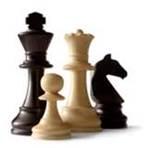
Rules Of Thumb
While cleaning out excess papers the other day, I ran accross this list. I do not know the source, but it all seems very good advice. It is worth further study to me, thus I feel it is worth passing on.
- Use the center pawns to gain space in the opening.
- Invade only with support.
- Do not lock in bishops.
- Exchange relieve cramped positions.
- Control the center of the board.
- Counter a wing attack with a center attack.
- After you control a square in enemy territory, occupy it with a knight.
- When ahead in material, force exchanges.
- Secure your King early.
- Try to keep your pawn structure intact.
- Try to keep pawns mobile or in duos.
- If a pawn becomes locked, to to use others to pry it free.
- Create passed pawns, especially protected passed pawns.
- Push passed pawns.
- Attack backwards pawns with heavy pieces.
- try to provoke a hanging pawn into advance then blockade.
- Avoid stacking your pawns, and try to force your opponent to stack his pawns.
- Try to exchange your stacked pawns.
- Attack pawn chains at their base.
- Look for pins, forks and skewers.
- Avoid the "good knight, bad bishop" end game by checking pawn structure.
- Do not move an already developed piece unless all pieces are developed, or you have good reason.
- If you have more pawns, exchange pieces, not pawns.
- If you have fewer pawns, exchange pawns, not pieces.
- When capturing with pawns, try to push your pawns to the center.
- Protect your pawns.
- Don't bring your queen out early.
- Use your king for end-game play.
- In pawn endings, put your king in front of, or beside your pawns.
- If your opponent has a bishop, keep you pawn chains on its color. If you have a bishop, keep your pawns on its opposite color, regardless of what your opponent has.
- In end game play, use your King to control the movement of your opponent's King.
- When facing a king and pawn after you have lost your material, try to keep your king in fron of your opponent's king. You may be able to force a stalemate.
- When your pawn and king are facing only an opponent's king, lead with your king and move the pawn only when necessary for its safety.
- Push pawns that are not obstructed by other pawns.
- Capture hanging pieces.
- Create hanging pieces by taking advantage of overburdened pieces.
- The one who captures last gets the most active piece.
- Don't start a wing attack if the control of center is in question.
